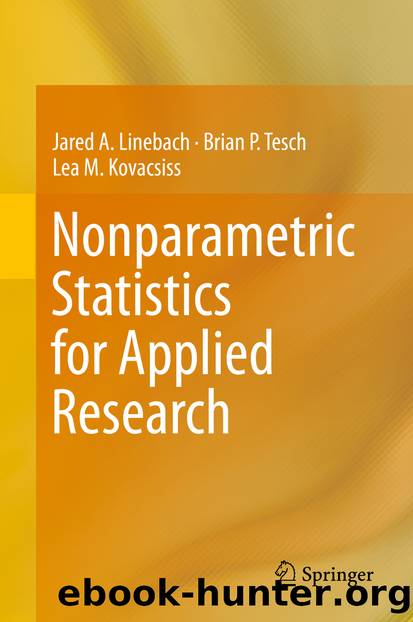Nonparametric Statistics for Applied Research by Jared A. Linebach Brian P. Tesch & Lea M. Kovacsiss

Author:Jared A. Linebach, Brian P. Tesch & Lea M. Kovacsiss
Language: eng
Format: epub
Publisher: Springer New York, New York, NY
“Now, the purpose of the Binomial Test is to determine whether or not the number of sex offenders we have falls into the categories of ‘on medication’ or ‘not on medication’ purely by chance. Now, the Binomial Test is an Exact Test; the assumption is that the derivation of the Distribution has been met.”
Suddenly, Dakota saw a mixture of fear and horror well up in Theron’s eyes; she had used way too many statistically based terms in her last sentence. She simply held up her hand in an effort to pacify him.
“All that language means is that the number of people who are Statistically Significant by chance will reflect your Alpha Level. If you are using a .05 Alpha Level, then you will only have 5% of your population get Statistical Significance purely by chance.”
Michael nodded.
“Ah, I get it. Most other tests use Approximations, which mean that a researcher can increase the Sample Size in order to accommodate a 5% Alpha Level. This test would help you get an Alpha of .05 regardless of the Sample Size.”
Robin sneered at Michael.
“That is fine and dandy that you understand this but I’m not sure I do. Are you saying that Approximations use the Sample Size to determine Significance?”
Michael, in an uncharacteristically helpful way, grinned at Robin.
“Yes, for most tests, the Sample Size is a concern because it provides some of the information for whether or not the test is Significant. For the Binomial Test, we do not have that same concern; regardless of our Sample Size, we can still determine Significance because this is an Exact Test.”
Dakota nodded at Michael, only slightly noticing that Theron was leaning forward on his elbows.
“So, are we operating under the assumption that there is a 50/50 chance that the offenders are taking medication?”
Dakota stopped for a few moments, trying to figure out the best possible way to explain this situation.
“Honestly, the 50/50 Probability is a pretty common Hypothesis. We only have two groups so, by default, the Probability parameter for both groups is 0.5. If you don’t like 0.5 or if 0.5 doesn’t make theoretical sense, you can change the probabilities. For the first group, you can use whatever Probability you fancy or whatever you have a theoretical basis for; this is sometimes called a Test Proportion. After you have determined the proportion for the first group, the second group’s Probability is easy to calculate. So, if we have reason to think that 7 out of 10 offenders will take their medication, then the Probability, or Test Proportion, of taking medication is .7, and the Probability of not taking medication is .3.”
Dakota reached behind her and jotted some information onto the dry-erase board.
P[X = 1] = p and P[X = 0] = 1–p = q
“All right, the uppercase P tells us that we are calculating Probability. The X = in brackets refer to whether we are calculating the Probability of a desired outcome or the expected outcome [X = 1] of Probability of an undesired outcome or the unexpected outcome [X = 0]. We only use
Download
This site does not store any files on its server. We only index and link to content provided by other sites. Please contact the content providers to delete copyright contents if any and email us, we'll remove relevant links or contents immediately.
Modelling of Convective Heat and Mass Transfer in Rotating Flows by Igor V. Shevchuk(6349)
Weapons of Math Destruction by Cathy O'Neil(6075)
Factfulness: Ten Reasons We're Wrong About the World – and Why Things Are Better Than You Think by Hans Rosling(4617)
Descartes' Error by Antonio Damasio(3183)
A Mind For Numbers: How to Excel at Math and Science (Even If You Flunked Algebra) by Barbara Oakley(3176)
Factfulness_Ten Reasons We're Wrong About the World_and Why Things Are Better Than You Think by Hans Rosling(3157)
TCP IP by Todd Lammle(3093)
Applied Predictive Modeling by Max Kuhn & Kjell Johnson(2973)
Fooled by Randomness: The Hidden Role of Chance in Life and in the Markets by Nassim Nicholas Taleb(2962)
The Tyranny of Metrics by Jerry Z. Muller(2950)
The Book of Numbers by Peter Bentley(2871)
The Great Unknown by Marcus du Sautoy(2608)
Once Upon an Algorithm by Martin Erwig(2536)
Easy Algebra Step-by-Step by Sandra Luna McCune(2534)
Lady Luck by Kristen Ashley(2493)
Practical Guide To Principal Component Methods in R (Multivariate Analysis Book 2) by Alboukadel Kassambara(2444)
Police Exams Prep 2018-2019 by Kaplan Test Prep(2438)
All Things Reconsidered by Bill Thompson III(2323)
Linear Time-Invariant Systems, Behaviors and Modules by Ulrich Oberst & Martin Scheicher & Ingrid Scheicher(2301)
